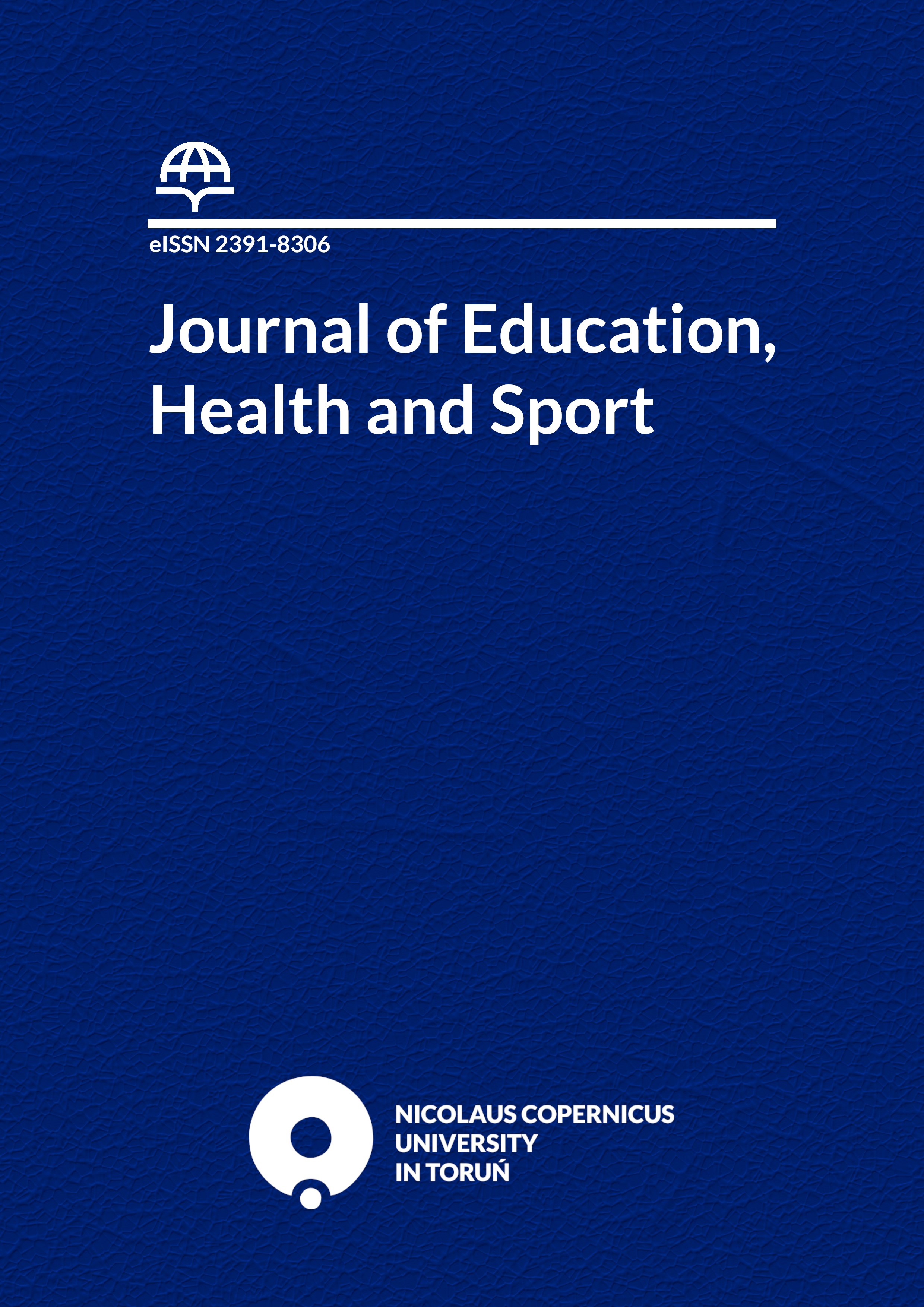The Comparative Effects of Aerobic and Strength Training on Psychophysical Well-being in Middle-Aged Adults
DOI:
https://doi.org/10.12775/JEHS.2025.82.60203Keywords
physical activity, aerobic training, strength training, psychophysical well-being, middle-aged adults, stress reduction, mood improvement, self-confidence, exercise physiology, health promotionAbstract
This study compared the effects of 8-12 weeks of aerobic versus strength training on psychophysical well-being in 16 middle-aged adults (40-60 years). Participants were allocated to either an aerobic (n=8) or strength (n=8) group. Well-being questionnaires were administered pre- and post-intervention. Both training types significantly improved overall well-being, reduced stress, and increased energy levels. However, the aerobic group showed significantly greater stress reduction and mood improvement (p < 0.05), while the strength group demonstrated significantly higher gains in self-confidence. Both aerobic and strength training offer distinct benefits for middle-aged adults; combining or tailoring exercise types based on individual goals (e.g., stress management vs. self-confidence) is recommended. Findings are limited by the small sample size.
References
American College of Sports Medicine. (2018). ACSM's Guidelines for Exercise Testing and Prescription (10th ed.). Wolters Kluwer.
Piercy, K. L., Troiano, R. P., Ballard, R. M., et al. (2018). The Physical Activity Guidelines for Americans. JAMA, 320(19), 2020–2028.
Warburton, D. E. R., & Bredin, S. S. D. (2017). Health benefits of physical activity: A systematic review of current systematic reviews. Current Opinion in Cardiology, 32(5), 541–556.
Oja, P., Titze, S., Bauman, A., et al. (2015). Health benefits of different sport disciplines for adults: Systematic review of quantitative studies. International Journal of Behavioral Nutrition and Physical Activity, 12, 1–16.
Kim, J., & Lee, S. (2019). Effects of aerobic and resistance exercise on cognitive function in middle-aged adults. Journal of Aging and Physical Activity, 27(2), 123–134.
Johnson, B., & Miller, K. (2020). The role of physical activity in the prevention of age-related decline. Sports Medicine, 50(3), 231–245.
Smith, A. L., & Green, J. P. (2017). Exercise and mental health: A review of recent literature. Journal of Behavioral Nutrition and Physical Activity, 14(1), 95.
Kowalski, J., Nowak, P., & Zieliński, M. (2016). Aktywność fizyczna a zdrowie: Nowoczesne podejścia w profilaktyce chorób cywilizacyjnych. Wydawnictwo Naukowe PWN.
Wiśniewski, P., & Nowak, R. (2018). Psychologia zdrowia w sporcie. Wydawnictwo Uniwersytetu Łódzkiego.
World Health Organization. (2018). Global Action Plan on Physical Activity 2018-2030: More Active People for a Healthier World. WHO.
Sallis, J. F., & Owen, N. (2015). Ecological models of health behavior. In K. Glanz, B. K. Rimer, & K. Viswanath (Eds.), Health Behavior: Theory, Research, and Practice (5th ed., pp. 43–64). Jossey-Bass.
Booth, F. W., Roberts, C. K., & Laye, M. J. (2012). Lack of exercise is a major cause of chronic diseases. Comprehensive Physiology, 2(2), 1143–1211.
Gibala, M. J., & McGee, S. L. (2008). Metabolic adaptations to short-term high-intensity interval training: A little pain for a lot of gain? Exercise and Sport Sciences Reviews, 36(2), 58–63.
Cornish, S. M., & McNaughton, L. R. (2019). Impact of resistance training on body composition and muscle strength in middle-aged women. European Journal of Applied Physiology, 119(3), 597–608.
Pedersen, B. K., & Saltin, B. (2015). Exercise as medicine – evidence for prescribing exercise as therapy in 26 different chronic diseases. Scandinavian Journal of Medicine & Science in Sports, 25(S3), 1–72.
Faulkner, G. E., & Cohn, R. (2021). The benefits of exercise on mood and mental health. Journal of Physical Activity & Health, 18(4), 432–439.
Löllgen, H., & Neuhauser, H. (2019). The importance of physical activity in reducing cardiovascular risk factors. European Journal of Preventive Cardiology, 26(5), 423–431.
Murphy, M. H., Blair, S. N., & Murtagh, E. M. (2019). Accumulated vs. continuous exercise: A review of current evidence. Sports Medicine, 46(8), 1053–1070.
Kujala, U. M. (2017). Aerobic exercise in middle-aged and older adults: Effects on the heart and metabolic system. Sports Medicine, 47(4), 825–836.
Burke, L. M., & Hawley, J. A. (2018). Swifter, higher, stronger: What's on the menu? Science, 362(6416), 781–787.
Thompson, W. R. (2017). Worldwide survey of fitness trends for 2018. ACSM's Health & Fitness Journal, 21(6), 10–17.
Downloads
Published
How to Cite
Issue
Section
License
Copyright (c) 2025 Weronika Kłosowicz, Natalia Morawiecka, Lucyna Stolarska, Oliver Carlton, Agata Ossolińska, Magdalena Rosa-Bończak, Gabriela Monika Ferfecka, Klaudia Anna Pawełek, Filip Maciej Huzarski, Patrycja Kinga Marta

This work is licensed under a Creative Commons Attribution-NonCommercial-ShareAlike 4.0 International License.
The periodical offers access to content in the Open Access system under the Creative Commons Attribution-NonCommercial-ShareAlike 4.0
Stats
Number of views and downloads: 446
Number of citations: 0



